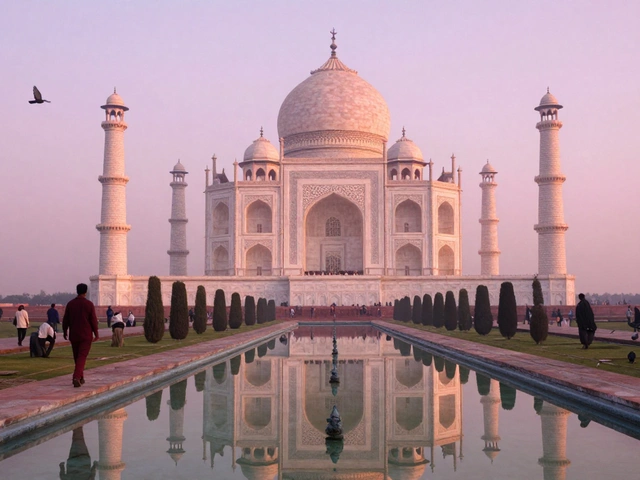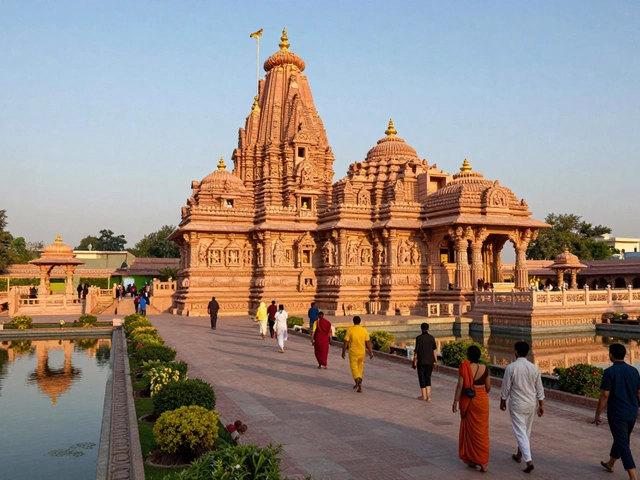Pilgrimage Status Checker
Check Pilgrimage Status
People often ask: Is Rameshwaram a Dham or a Jyotirlinga? The answer isn’t simple because it’s both - and that’s what makes it unique. If you’re planning a pilgrimage to South India, understanding this distinction matters. You’re not just visiting a temple. You’re stepping into one of the most powerful spiritual crossroads in Hinduism.
What Makes Rameshwaram Special?
Rameshwaram is one of the twelve Jyotirlingas - the most sacred shrines dedicated to Lord Shiva. According to ancient texts like the Shiva Purana, these Jyotirlingas are places where Shiva appeared as a column of light. Each Jyotirlinga has its own story, but Rameshwaram’s ties directly to the Ramayana. It’s said that after defeating Ravana, Lord Rama washed his sins in this very spot and installed a Shiva Linga to seek forgiveness. That Linga is the one worshipped here today.
But Rameshwaram is also one of the four Char Dham sites - the four holiest pilgrimage destinations in Hinduism. The others are Badrinath in the north, Puri in the east, and Dwarka in the west. Pilgrims believe that visiting all four Dham sites in a lifetime brings moksha - liberation from the cycle of rebirth. So Rameshwaram isn’t just a Shiva temple. It’s part of a sacred circuit that shapes the spiritual journey of millions.
Jyotirlinga vs. Dham: What’s the Difference?
People mix up these terms all the time. A Jyotirlinga is specifically a form of Shiva. There are only twelve in all of India, and each has deep mythological roots tied to divine appearances. Rameshwaram, Kedarnath, Somnath, and others fall into this category.
A Dham, on the other hand, is a broader term. It means a holy place or abode of the divine. The Char Dham are Dham because they represent the four cardinal directions and are linked to different deities: Rameshwaram (Shiva), Badrinath (Vishnu), Puri (Jagannath, an avatar of Vishnu), and Dwarka (also Vishnu). So while all Jyotirlingas are holy, not all Dhams are Jyotirlingas.
Rameshwaram is rare because it holds both titles. It’s a Jyotirlinga because of the Shiva Linga installed by Rama. And it’s a Dham because it’s one of the four sacred destinations that complete the pilgrimage circuit. You won’t find another site in India that holds both distinctions so clearly.
Why This Matters to Pilgrims
If you’re planning a spiritual trip, knowing Rameshwaram’s dual status changes how you approach it. Pilgrims who complete the Char Dham often time their visits to include the Jyotirlinga darshan as a key part of their journey. Many start with Badrinath, then head to Puri, Dwarka, and finally Rameshwaram - ending their pilgrimage where the sea meets the land, just as Rama did.
The temple’s architecture reflects this importance. The Ramanathaswamy Temple has the longest corridor of any Hindu temple in India - over 1,200 pillars lining the pathways. Devotees walk these corridors while chanting prayers, sometimes covering the entire length multiple times. The water from the 22 holy wells inside the temple complex is used for ritual bathing. Each well is named after a different form of Shiva, and taking a dip in them is believed to cleanse sins.
During Maha Shivaratri, the temple sees over 200,000 visitors in just a few days. The abhishekam - the ritual bathing of the Linga - is performed with milk, honey, and sacred water drawn from the nearby ocean. The sound of bells, chants of "Om Namah Shivaya," and the smell of incense fill the air. This isn’t just a temple visit. It’s a sensory immersion into centuries of devotion.

What You’ll See When You Visit
Arriving in Rameshwaram feels different from other temple towns. The air is salty. The sea is close. The temple complex is massive, but the town itself is quiet, almost reverent. You’ll find pilgrims walking barefoot, carrying small pots of Ganga water, or tying sacred threads around their wrists after offering prayers.
The main shrine houses the Rama Lingam - the self-manifested (Swayambhu) Jyotirlinga. Legend says Rama asked Hanuman to bring a Linga from Kailash. When Hanuman was delayed, Sita made a Linga from sand. That’s the one worshipped here. The temple also holds the footprints of Hanuman and a stone slab said to be from the bridge Rama built to Lanka.
Don’t miss the northern corridor, where you’ll find the 22 teerthas (holy wells). Each one is believed to have been created by Rama himself. Pilgrims collect water from these wells to take home as prasad. The temple priests still use the same ancient methods to draw the water - no pumps, no modern machinery.
When to Visit and What to Expect
The best time to visit is between October and March, when the weather is cool and dry. The temple opens at 5:30 a.m. and closes at 1 p.m., then reopens from 4 p.m. to 9 p.m. The evening aarti is especially moving - the entire temple glows with oil lamps, and the chants echo through the corridors.
During the annual Rama Navami festival in March or April, the temple celebrates Rama’s birth with special rituals. The Linga is decorated with flowers, and the temple grounds become a sea of saffron-clad devotees. If you’re visiting then, book your stay weeks in advance. Guesthouses fill up fast.
Many pilgrims combine Rameshwaram with a trip to Kanyakumari, just 170 kilometers away. You can see the confluence of three seas - the Bay of Bengal, the Arabian Sea, and the Indian Ocean - and visit the Vivekananda Rock Memorial. It’s a natural extension of the spiritual journey.

Common Misconceptions
Some believe Rameshwaram is only a Jyotirlinga and not a Dham. That’s incorrect. The four Dham are defined by ancient texts like the Padma Purana and are recognized by all major Hindu sects. The Shankaracharya himself established the Char Dham pilgrimage circuit in the 8th century, and Rameshwaram was included from the start.
Others think the Jyotirlinga here is just a symbolic representation. But the temple’s rituals, the continuous worship for over 1,300 years, and the belief in its Swayambhu nature make it as real and powerful to devotees as any other Jyotirlinga. The fact that Rama, a Vishnu avatar, worshipped Shiva here also shows the deep unity between the two major traditions in Hinduism.
And no, you don’t need to be Hindu to visit. People of all faiths are welcome. But you must follow the rules: remove your shoes before entering, cover your head in the inner sanctum, and avoid bringing leather items inside. These aren’t restrictions - they’re signs of respect.
Final Thoughts
Rameshwaram isn’t just a temple. It’s a living bridge between myth and reality, between devotion and history. It’s where a king became a devotee, where the sea met the sacred, and where two of Hinduism’s most important concepts - Jyotirlinga and Dham - came together in one place.
If you’ve ever wondered why millions walk hundreds of kilometers to reach this island, now you know. It’s not about the architecture. It’s not even about the rituals. It’s about standing where Rama stood, touching the Linga he installed, and feeling connected to something older than time itself.
Is Rameshwaram a Jyotirlinga or a Dham?
Rameshwaram is both. It is one of the twelve Jyotirlingas - sacred shrines of Lord Shiva - and also one of the four Char Dham pilgrimage sites in Hinduism. This dual status makes it unique among Indian temples.
Why is Rameshwaram considered a Jyotirlinga?
According to the Ramayana, Lord Rama installed a Shiva Linga here to atone for killing Ravana, a Brahmin. The Linga is believed to be Swayambhu - self-manifested - and has been worshipped continuously for over a millennium. It is recognized in the Shiva Purana as one of the twelve Jyotirlingas.
What is the Char Dham pilgrimage?
The Char Dham consists of four sacred sites: Rameshwaram in the south, Badrinath in the north, Puri in the east, and Dwarka in the west. Pilgrims believe that visiting all four in a lifetime brings moksha, or liberation from rebirth. Each site is linked to a different deity, but Rameshwaram is the only one that is also a Jyotirlinga.
Can non-Hindus visit Rameshwaram Temple?
Yes, people of all faiths are welcome to visit the temple. However, visitors must follow the rules: remove footwear before entering, cover the head inside the sanctum, and avoid bringing leather items. These are signs of respect, not restrictions.
How many holy wells are there in Rameshwaram Temple?
There are 22 holy wells, called teerthas, inside the temple complex. Each one is named after a different form of Shiva and is believed to have been created by Lord Rama. Devotees collect water from these wells as prasad, and the temple priests still draw the water using traditional methods.
When is the best time to visit Rameshwaram?
The best time to visit is between October and March, when the weather is cool and dry. Major festivals like Maha Shivaratri and Rama Navami draw huge crowds, so plan ahead if you want to avoid the rush. The temple is open from 5:30 a.m. to 1 p.m. and 4 p.m. to 9 p.m. daily.
What to Do Next
If you’ve decided to visit Rameshwaram, start by checking the temple’s official timings and booking accommodation early - guesthouses fill up fast during festivals. Many pilgrims combine the trip with a visit to Kanyakumari or the Gulf of Mannar Marine National Park. You can also take a short boat ride to the nearby Adam’s Bridge (Ram Setu), the ancient stone formation believed to be the bridge built by Rama’s army.
Bring light cotton clothes, a head covering, and plenty of water. The walk from the bus stand to the temple is long, and the sun can be strong even in winter. Don’t rush. Let the silence of the temple corridors, the sound of the waves, and the scent of incense guide you. This isn’t a tourist stop. It’s a turning point.






